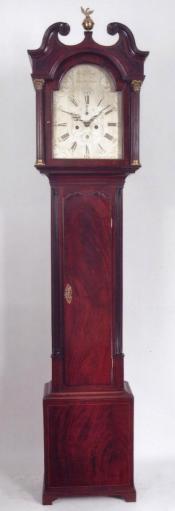Adam Pringle of Edinburgh, Scotland. A very attractive tall clock. 212004.
212004 Adam Pringle of Edinburgh, Scotland.
This very attractive tall case clock represents one of the best forms of Scottish tall case production. This Edinburgh example exhibits excellent narrow proportions and is constructed in richly figured mahogany wood.
This case retains an older finish that has been recently waxed. As a result, the wood has a darker tone, and the brass has taken a mellow patina. The case stands on four small applied bracket feet. The base panel features a cross-banded border delineated from the central panel by a thin string inlay of blonde satinwood. The panel is richly figured, adding visual interest to this section. The waist is long and narrow, centering a large waist door nicely shaped at the top and trimmed with a molded edge. This door also exhibits an excellent mahogany grain pattern that flows upward. Open this door, and you can access the weights and pendulum in the case's interior. The side of the waist or corners are fitted with robust quarter columns decorated with fluting and terminate in turned wooden capitals. The bonnet features a swan's neck pediment. The arches or swan's necks are nicely formed and exhibit good height. They terminate with ring-turned rosettes and conveniently center a brass finial at the top of the case. The facade under the moldings is inset with veneered mahogany panels. This is a very nice additional detail. Fully turned and fluted bonnet columns terminate in brass capitals. The top capitals are a robust Corinthian form. These columns flank the glazed bonnet door.
The single-sheet brass dial is skillfully engraved and has been treated with a silvered wash. The center of this dial is decorated with a fancy floral design. The foliage in the spandrel areas terminate with eagle or serpent heads. This subtle detail suggests that the dial was engraved in Scotland. This clock is in the arch of the dial. This is surrounded by additional engravings that terminate in a mythological type of animal composed of a horse's head and a dragon's tail. The time ring is traditionally formatted with Roman hour numerals, Arabic five-minute makers, subsidiary seconds dial, and a small circular calendar date aperture.
The weight-driven movement, a testament to the craftsmanship of the time, is constructed in brass and is designed to run for eight days on a full wind. It strikes each hour on a bell mounted above the movement. Each train is powered by a weight, ensuring the clock's reliable performance. Overall, it is of exceptional quality, a feature that enthusiasts will appreciate.
This clock, made circa 1790, stands approximately 7 feet 4.5 inches tall to the top of the center finial.
Adam Pringle is listed in Donald Whyte's Clockmakers and Watchmakers of Scotland. He is listed as working on Bristo Street in 1782 through 1820. In 1782 he married Anne Campbell the daughter of James Campbell of Dunfermline.
Inventory number 212004.
Adam Pringle is listed in Donald Whyte's Clockmakers and Watchmakers of Scotland. He is listed as working on Bristo Street in 1782 through 1820. In 1782 he married Anne Campbell the daughter of James Campbell of Dunfermline.












